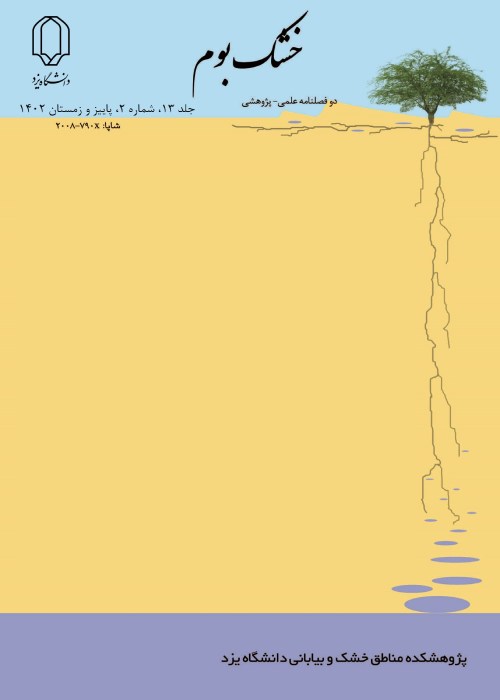Studying the five-year results of the growth and survival of six tree species in the green space of Robat Karim in climatic uncertainty
Author(s):
Article Type:
Research/Original Article (دارای رتبه معتبر)
Abstract:
The main challenge to compromising with climate change from a management approach is dealing with the uncertainty of future climate changes. Analyzing the effect of climate change on tree species used for afforestation in Robat Karim as a city in the central arid regions of Iran was the purpose of this study. Afforestation with two-year seedlings of Mulberry (Morus alba), Tehran pine (Pinus eldarica), Tree of heaven (Ailanthus altissima), Ash (Fraxinus rotundifolia), Blackberry (Acer negundo), and, Acacia (Robinia pseudoacacia) took place after preparing the planting substrate in 2016. The diameter of the trunk, the height of the seedlings, the freshness of the leaves (good, medium, and pale), and the health of the seedlings (healthy, semi-healthy, infested) were measured during the planting. These parameters were measured again in 2022 after five years. Furthermore, to analyze the trend of seven climatic factors such as mean temperature (°C), mean maximum temperature (°C), the mean minimum temperature (°C), mean wind speed (m/s), the mean number of daily sunny hours from 1951 to 2021 and average reference evapotranspiration (mm) from 1991-2021, was carried out. The analysis results of climate elements showed that climate changes are taking place in the form of an increase in the mean annual temperature, an increase in the maximum and minimum temperature, a reduction in the total annual rainfall, a decrease in the wind speed, and an increase in the reference evaporation and transpiration. The number of Boxelder maple reached 80 trees, while the number of Tehran pine and Acacia seedlings did not change much and were equal to 145 individuals in 2022. The highest annual diameter growth rate includes Acacia and Tehran pine with 1.1 and 1.05 cm, respectively, while the lowest annual diameter growth rate involves black maple with 0.78 cm. The ANOVA test results to compare the condition of the trees in terms of the decay degree of the studied species in 2022 indicate a significant difference (p=0.05) between the studied groups. The priority is to determine native species and species such as Tehran pine and Acacia that can adapt to occurring tensions.
Keywords:
crown area , diameter , dry climate , height , plantation , Precipitation , Temperature
Language:
Persian
Published:
Journal of Arid Biome, Volume:12 Issue: 1, 2023
Pages:
107 to 119
magiran.com/p2619604
دانلود و مطالعه متن این مقاله با یکی از روشهای زیر امکان پذیر است:
اشتراک شخصی
با عضویت و پرداخت آنلاین حق اشتراک یکساله به مبلغ 1,390,000ريال میتوانید 70 عنوان مطلب دانلود کنید!
اشتراک سازمانی
به کتابخانه دانشگاه یا محل کار خود پیشنهاد کنید تا اشتراک سازمانی این پایگاه را برای دسترسی نامحدود همه کاربران به متن مطالب تهیه نمایند!
توجه!
- حق عضویت دریافتی صرف حمایت از نشریات عضو و نگهداری، تکمیل و توسعه مگیران میشود.
- پرداخت حق اشتراک و دانلود مقالات اجازه بازنشر آن در سایر رسانههای چاپی و دیجیتال را به کاربر نمیدهد.
In order to view content subscription is required
Personal subscription
Subscribe magiran.com for 70 € euros via PayPal and download 70 articles during a year.
Organization subscription
Please contact us to subscribe your university or library for unlimited access!



